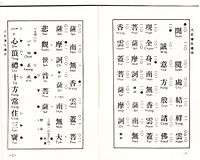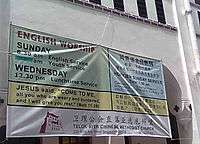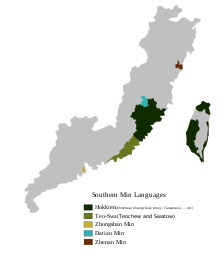Singaporean Hokkien
| Singapore Hokkien | |
|---|---|
|
新加坡福建话 (Sin-ka-pho Hok-kiàn ōe) | |
| Native to | Singapore |
Native speakers | 1.2 million (2017)[1] |
|
Latin (pe̍h-ōe-jī) Han characters (traditional or simplified) | |
| Official status | |
Official language in | None, Lingua franca of the Chinese community in Singapore before 1979. |
| Regulated by | None |
| Language codes | |
| ISO 639-3 | – |
| Glottolog | None |
| Singaporean Hokkien | |||||||||||||
| Traditional Chinese | 新加坡福建話 | ||||||||||||
|---|---|---|---|---|---|---|---|---|---|---|---|---|---|
| Hokkien POJ | Sin-ka-pho Hok-kiàn-ōe | ||||||||||||
| |||||||||||||
| Traditional Chinese | 新加坡閩南語 | ||||||||||||
| Hokkien POJ | Sin-ka-pho bân-lâm-gu / Sin-ka-pho bân-lâm-gí | ||||||||||||
| |||||||||||||
| Traditional Chinese | 新加坡閩南話 | ||||||||||||
| Hokkien POJ | Sin-ka-pho bân-lâm-ōe | ||||||||||||
| |||||||||||||
 Life in Singapore |
|---|
Singaporean Hokkien (Chinese: 新加坡福建话; Pe̍h-ōe-jī: Sin-ka-pho Hok-kiàn-ōe; Tâi-lô: Sin-ka-pho Hok-kiàn-uē) is a local variant of the Hokkien language spoken in Singapore. In Chinese academic circles, this dialect is known as Singaporean Ban-Lam Gu (新加坡閩南語, Sin-ka-pho bân-lâm-gu). It is closely related to the Southern Malaysian Hokkien (南马福建话) spoken in Southern Malaysia, as well as to Riau Hokkien (廖内福建话) spoken in the Indonesian province of Riau. It also closely resembles Amoy (厦门话) spoken in Amoy, China, and Taiwanese Hokkien (台灣閩南語/台語/台灣話) which is spoken in Taiwan.
Hokkien, is the Min Nan pronunciation for Fujian province, China, and is generally the term used by the Chinese in South-East Asia to refer to the Banlam dialect (闽南语). Singaporean Hokkien generally uses Amoy as its standard, and its accent is predominantly based on a mixture of Quanzhou (泉州话) and Zhangzhou (漳州话) speech, with a greater inclination towards the former.
Like many spoken languages in Singapore, Singaporean Hokkien is influenced by other languages or dialects spoken in Singapore. For instance, Singaporean Hokkien is influenced to a certain degree by Teochew, and is sometimes regarded as a combined Hokkien-Teochew speech (福潮话). In addition, it has many loanwords from Malay and English.
Nevertheless, the grammar and tones of Singaporean Hokkien are still largely based on Minnan. When compared to Taiwanese's prestige accent (台语优势腔) spoken in Tainan (台南) and Kaohsiung (高雄), Singaporean Hokkien pronunciation inclines toward the Quanzhou accent (泉州腔), is also close to the pronunciation of Taipei and Amoy, and is less close to that of Tainan which has a greater inclination towards the Zhangzhou accent (漳州腔).
A Singaporean would likely not have trouble conversing with Taiwanese speakers in Singaporean Hokkien, with the exception of some Japanese loanwords. Similarly, Singaporean Hokkien is understood by Taiwanese speakers, with the exception of some Malay and English loanwords.
History
From the 19th until the early half of the 20th century, there was a large influx of Chinese migrants from southern China into Singapore. This led to Chinese constituting almost 75% of Singapore's population. Of these Chinese, many originated from the regions of Quanzhou and Zhangzhou in Fujian province. They brought Min Nan to Singapore, which was then propagated throughout Singapore and Malaysia. As there was no formal Chinese name for Min Nan in the early 20th century, these migrants began to use their place of origin as the name of their speech, and thus called the dialect "Hokkien" (福建) (which means "Fujian" province).
During the 19th century, many traditional private Chinese schools in Singapore (known as su-sio̍k-á, 私塾仔) generally used Hokkien to teach Chinese classics and Classical Chinese. But by the early 20th century, Mandarin began to replace Hokkien as the medium of instructions in Chinese schools after the founding of many Mandarin-medium schools.
During the 1950s and 1960s, many political speeches in Singapore were in Hokkien, in order to reach out to the Chinese community in Singapore. There was also a thriving Hokkien cultural scene that included Hokkien story-telling, opera, and media in Singapore.
After 1979, the Singapore government began to push for the use of Mandarin in Singapore, spearheaded by the Speak Mandarin Campaign. Following this, the Singapore government also began to employ a more stringent censorship, or ban, of Hokkien media in the Singaporean Chinese media. Consequently, all Hokkien-language media in Singapore had to be dubbed in Mandarin before being allowed to stream on national TV. In addition, the 1980s saw Chinese-medium education replaced by that in English, causing English to emerge as the most widely used language in Singapore. The emergence of the English language, coupled with heavy promotion of Mandarin, generally led Hokkien to decline in Singapore after 1979.
Current status
Today, the lingua franca of the Chinese Community in Singapore is Mandarin. Although Hokkien is still spoken in Singapore today, particularly by the elderly Chinese population, it is not as widespread as before. The most common places to hear or speak Hokkien in Singapore are the Hawker centre or Kopi tiam.
Speaking ability varies amongst the different age groups of the Hokkien Singaporeans. The elderly are generally able to communicate effectively in Hokkien. On the other hand, the middle and younger generations have generally lost the ability to communicate as fluently. With the "Mandarin campaign" from the government, the Hokkien speaking population has declined greatly.
Revival through social media
There is, however, a minority group of Hokkien Singaporeans and Taiwanese living in Singapore working to help preserve, spread and revive the use of Hokkien Chinese in Singapore.
The ease of access to online Hokkien entertainment media and pop music from Taiwan helps to connect to the language and culture. Many Singaporeans are increasingly using online and social media platforms, such as Facebook and Meetup groups, to learn, discuss, meet, and interact with each other in Hokkien.
Some of the groups include:
Facebook Singapore Hokkien Language and Culture Society: Discussion forum on all aspects of Hokkien Chinese, with a primary focus on the Singaporean Hokkien dialect and its variations from other forms of Hokkien.
Facebook Singapore Hokkien Meetup: Group that organizes regular meetups for language practice. It also organizes free language courses and sharing sessions for those who are interested.
Singapore Hokkien Language Meetup Group: Same as the Facebook group, but organized over Meetup.
Phonology
Consonants
| Bilabial | Alveolar | Alveolo-palatal | Velar | Glottal | ||||||
|---|---|---|---|---|---|---|---|---|---|---|
| Voiceless | Voiced | Voiceless | Voiced | Voiceless | Voiced | Voiceless | Voiced | Voiceless | ||
| Nasal | m [m] 名 (miâ) | n [n] 耐 (nāi) | ng [ŋ] 硬 (ngǐ) | |||||||
| Plosive | Unaspirated | p [p] 邊 (pian) |
b [b] 文 (bûn) |
t [t] 地 (tē) |
d [d]* 日 (di̍t) | k [k] 求 (kiû) |
g [g] 牛 (gû) |
ʔ [ʔ] 音 (im) | ||
| Aspirated | ph [pʰ] 波 (pho) | th [tʰ] 他 (thaⁿ) | kh [kʰ] 琴 (khîm) | |||||||
| Affricate | Unaspirated | ch [ts] 曾 (chan) |
j [dz]* 熱 (jua̍h) |
chi [tɕ] 祝 (chiok) |
ji [dʑ]* 入 (ji̍p) | |||||
| Aspirated | chh [tsʰ] 出 (chhut) | chhi [tɕʰ] 手 (chhiú) | ||||||||
| Fricative | s [s] 衫 (saⁿ) | si [ɕ] 心 (sim) | h [h] 火 (hé) | |||||||
| Lateral | l [l] 柳 (liú) | |||||||||
| Labialized | w [w] 我 (wá) | |||||||||
- *Pronounced in some regional variations of the Hokkien language spoken in Singapore.
- The voiced plosives (/b/ and /ɡ/) become the corresponding fricatives ([β] and [ɣ]) in certain phonetic contexts such as during fast speech.
Regional accents and tonesWhen Singaporeans are speaking Hokkien, they will do it with various accents and tones largely from Tong'an, Anxi, Nan'an, Kinmen as well as Yongchun, Jinjiang, Longhai City and Southern Zhangzhou accents. In practice, it is common for Singaporeans to mix English conjunctions such as "and" into a Hokkien sentence. Some would include hngo2 (an exclamatory remark in Jin'jiang /Nan'an), in addition to the widely used lah and lor Hokkien exclamations. No differentiation between Literary and Vernacular PronunciationIn saying years or numbers, Singaporean Hokkien normally does not differentiate between literary (文讀音)or vernacular (白讀音) pronunciations. In Taiwan or Amoy, differentiation is usually made. For instance, the Year "1980" should be said with a literary pronunciation(一九八空年, it kiú pat khòng nî); but in Singapore, no differentiation is made (literary and vernacular are mixed together) and it's pronounced as it káu pueh khòng nî. Taiwanese would speak telephone numbers using literary pronunciations, while Singaporeans would use vernacular pronunciations instead. For example, the telephone number "98444678" will be pronounced in Taiwan using a literary pronunciation, as kiú pat sù sù sù lio̍k tshit pat, whereas in Singaporean Hokkien it would be pronounced using vernacular pronunciation, as káu pueh sì-sì sì la̍k tshit pueh. Influence from Southern Zhangzhou and Teochew PhonologyA change of vowel from ing to engIn Singaporean Hokkien—as compared to Quanzhou (whose accent Hokkien usually inclines toward), Zhangzhou, Amoy or Taiwanese (all being standard Hokkien), which pronounce the vowel ing—there is a vowel change from ing (/iəŋ/) to eng (/eŋ/ or /ɛŋ/). This change is similar to pronunciation in regions south of Zhangzhou—Dongshan, Yunxiao, Zhangpu, and Pinghe counties (southern Zhangzhou accent, 漳南腔)—and in Teochew and Cantonese. Below is a table illustrating the difference:
Pronunciation of 我 ("I")In standard Hokkien pronunciation, 我 ("I" or "me") is pronounced as /gʊa52/; but in Singaporean Hokkien, it is pronounced as /wa52/, is alleged by some to have been influenced by the Teochew pronunciation /ʊa52/ as many other dialects like Putianese and some regional Hokkien dialects have a nearly identical pronunciation of that. GrammarThere are some differences between the sentence structure used by Singaporean Hokkien and by Standard Hokkien (Amoy/Taiwanese). For instance, when asking a question for "do you want to...?", Singaporean Hokkien typically uses the sentence structure "愛 (ai)...莫 (mài)?", whereas Taiwanese Hokkien uses "欲 (beh)...無 (bô)". Singaporean Hokkien typically uses the word "愛 (ai)" to mean "want to", but in Taiwanese, the word "欲/卜 (beh)" (which means "want" in Hokkien) is used instead. "愛 (ai)" in Taiwanese typically means "love to" or "need to". Also, unlike Taiwanese Hokkien—which typically uses the word "敢 (kám)" (meaning "whether or not", 是否 /是不是) when asking a question, which is more formal or polite—Singaporean Hokkien does not use the word "敢 (kám)". Instead, it simply adds the word "無 (bô)" at the end of the sentence to indicate that it's a question (similar to Mandarin's "嗎 (ma)" or adds a Cantonese intonation "咩 (meh)" at the end. Adding the word "無 (bô)" at the end of a sentence is also used in Taiwanese Hokkien, when one is asking a question in an informal way.
NumeralsThe following list shows the colloquial readings of the numerals used to count objects.
Most ordinal numbers are formed by adding 第 [tē] in front of a cardinal number. In some cases, the literary reading of the number must then be used. For example, 第一 = tē-it, 第二 = tē-jī. See: Literary and colloquial readings of Chinese characters. Differences from Standard Hokkien (Amoy/Taiwanese)There are minor differences between Singaporean Hokkien and Amoy or Taiwanese in terms of vocabulary, pronunciation, and grammar. Amoy and Taiwanese bear close resemblance, and are usually considered the standard in Hokkien, differing only in terms of vocabulary. Unique vocabularyAlthough Singaporean Hokkien is similar to Amoy or Taiwanese, there exist certain uniquely Singaporean Hokkien words, which are different from the Amoy or Taiwanese.
Same meaning, different words
Same word, different pronunciationThere are some words used in Singaporean Hokkien that are the same in Taiwanese Hokkien, but are pronounced differently.
Influences from other local languagesBecause Singapore is a multilingual country, Singaporean Hokkien has been influenced by many other languages spoken in Singapore. As a result, there are many non-Hokkien words that have been imported into Singaporean Hokkien, such as those from Malay, Teochew, Cantonese, and English. Loanwords from other Chinese varietiesThere are words in Singaporean Hokkien that originated from other Chinese variants spoken in Singapore.
Malay loanwordsThe following are the common Malay loanwords used in Singaporean Hokkien. Most of them are also used in Amoy.
English loanwordsThere are also many English loanwords used in Singaporean Hokkien. They are usually used when the speaker does not know the Hokkien equivalent. Some of these English terms are related to working and living in Singapore
Loanwords from Old ChineseCertain colloquial pronunciations of Singaporean Hokkien words are directly inherited from the consonant system of Old Chinese. Hokkien did not experience a great phonological change throughout the transition period from Old Chinese to Middle Chinese. Singaporean Hokkien preserved a unique feature of Old Chinese: it does not have the consonant "f". For instance, the word "分" is not pronounced as fen, but rather as pun. This marks a major difference between Old Chinese and Middle Chinese. Singaporean Hokkien also preserved the nasal vowel and the sai vowel of Old Chinese.
Cultural useIn religion Extract from a Buddhist repentance sutra "大悲懺法儀規" (with Singapore-style Hokkien romanization) taken from a Buddhist temple in Singapore  A display outside Telok Ayer Chinese Methodist Church showing Hokkien Sunday Services (on the right side) Some of the Buddhist temples in Singapore continue to have Buddhist sutra being recited in Hokkien. The sutra contain Singapore-style Hokkien romanization to help in the recitation. Some of the Chinese Christian churches in Singapore also have services conducted in Singaporean Hokkien. Many of the Taoist services continue to be in Hokkien. MusicThere exist Singaporean Hokkien writings, folk adages, and ballads written by early Chinese immigrants to Singapore. Amongst the folk ballads, a few outstanding writings tell of the history and hardship of early Chinese immigrants to Singapore. There are 18 sections in the poetry ballad "行船歌" (Hâng-chûn-koa) ("Songs of traveling on a boat"), which talks about how early immigrants migrated to Singapore. There is another ballad called "砰嘭水中流" (Pin-pong-chúi-tiong-lâu) ("Flow in the midst of water"):
An example of a folk love ballad is "雪梅思君" (Soat-m̂-su-kun) ("Snow and plum thinking of a gentlemen"), on the loyalty and chastity of love.[2] An example of love poetry is "針線情" (Chiam-sòaⁿ-chiâⁿ) ("The emotions of needle and thread"):
GetaiSingapore also held Getai during traditional Chinese festivals, for instance the Hungry Ghost Festival. During the Getai event, it is common to speak a number of Chinese dialects, including Hokkien, Teochew, and Cantonese. During the 1960s, Hokkien song was particularly popular. The Singapore Hokkien star Chen Jin Lang (陳金浪) was once the compere and main singer during the Hungry Ghost Festival. His famous song "10 levels of Hades" ("十殿閻君") was especially popular. In operaEarly Singaporean Hokkien opera had its origins in Gaojia opera, which was brought from Quanzhou to Singapore during the late 19th century. In 1927, the Taiwanese Gezai opera spread to Singapore. Because its lyrics and singing style were easier to understand, it made a great impact on Singapore. Consequently, by the mid 20th century, it had replaced Gaojia opera to become the mainstream Hokkien opera in Singapore. Currently, Singapore Hokkien opera is performed by two older troupes—Sin Sai Hong Hokkien Opera Troupe (新賽風閩劇團) and Xiao Kee Lin Hokkien Opera Troupe (筱麒麟閩劇團)—and three newer troupes—Sio Gek Leng Hokkien Opera Troupe (筱玉隆閩劇團), Ai Xin Hokkien Opera Troupe (愛心歌仔戲團), and Do Opera [Hokkien] (延戏[福建歌仔戏]), which is the newest. A Singapore Chinese opera school nurtures talents in opera, including Hokkien opera. In moviesSingapore Hokkien movies began to appear in the late 1990s, notably by dubbing in Hokkien mainstream Chinese movies made in Singapore. Amongst these, movies directed by Jack Neo, such as I not stupid and Money No Enough were popular. They reflected the social environment of local Singaporeans. In radioAlthough Singapore radios started to ban Hokkien in the 1980s, Rediffusion Singapore continued to broadcast in Hokkien and greatly contributed to the culture of Singapore. For instance, the Hokkien story-telling program Amoy folks story (廈語民間故事), by Xu Shumei (許淑梅), was very popular. NanyinNanyin (Southern Music) first spread to Singapore in 1901.[3] Many immigrants from Quanzhou began to establish various Nanyin organizations. Those which survive include the Siong Leng Musical Association, which was established in 1941. It was responsible for promoting Nanyin, as well as Liyuan opera. In 1977, the then chairman of the association, Ting Ma Cheng (丁馬成), advocated for the ASEAN Nanyin Performance (亞細安南樂大會奏), which helped to revive Nanyin. In addition, in order to educate young people about this performance art, he also published two books on Nanyin and Liyuan opera.[4] Currently, the Siong Leng Musical Association is led by Ding Honghai (丁宏海), and it continues to promote Nanyin in Singapore. Footprints of Peh-oe-ji Provided by descendant of Tan Boon Hak, 陈文学, a cousin of Tan Kah Kee, who donated it to the Brownies for the exhibition There are some letters written in Peh-oe-ji from early Hokkien migrants in Singapore. An example was provided by the descendant of Tan Book Hak, a cousin of Tan Kah Kee.[5]
Places in SingaporeSingapore's Chinese name "新加坡" (sin-ka-pho) originated from Hokkien's transliteration of "Singapore". In addition, there are many other place names in Singapore that originated from Hokkien: Ang Mo Kio and Toa Payoh, for instance. See alsoReferences
Further reading
External links |
